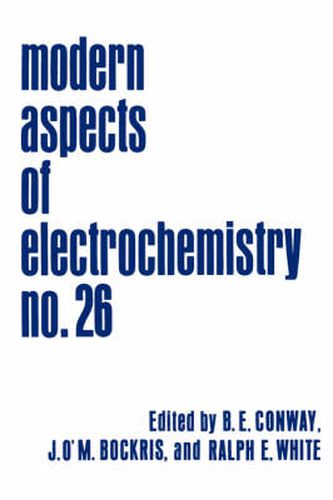Readings Newsletter
Become a Readings Member to make your shopping experience even easier.
Sign in or sign up for free!
You’re not far away from qualifying for FREE standard shipping within Australia
You’ve qualified for FREE standard shipping within Australia
The cart is loading…






This title is printed to order. This book may have been self-published. If so, we cannot guarantee the quality of the content. In the main most books will have gone through the editing process however some may not. We therefore suggest that you be aware of this before ordering this book. If in doubt check either the author or publisher’s details as we are unable to accept any returns unless they are faulty. Please contact us if you have any questions.
The present volume presents six chapters, two of them fairly brief, covering both fundamental and applied electrochemistry. The latter aspect has, of course, historical significance in the subject as well as a major technological profile in recent decades, while intimate connections between these complementary facets of the subject have always been a driving force for its earlier and continu ing development. In the Modern Aspects of Electrochemistry series we have periodically included contributions from the several schools of Russi~n electrochemistry. This approach is continued in the present volume by inclusion of the chapter by Benderskii, Brodskii, Daikhin, and Velichko from the Frumkin Institute, Moscow, on phase transitions among molecules adsorbed in the double-layer interphase at electrodes. This topic has attracted attention for some years through the works of the Russian school and of Gierst and Buess-Herman. Such behavior is also related to the important phenomenon of self-assembly of molecules in films at interfaces. In Chapter 1, these authors give an account of the factors associated with two-dimensional phase transitions and associated orientation effects with polar adsorbates at electrode interfaces. The theoretical interpretation of these effects are also treated in some detail. Chapter 2, by Rusling, deals with electrochemistry and electro catalysis in microemulsions, thus connecting aspects of electrode kinetics, adsorption at electrode interfaces, and colloid chemistry.
$9.00 standard shipping within Australia
FREE standard shipping within Australia for orders over $100.00
Express & International shipping calculated at checkout
Stock availability can be subject to change without notice. We recommend calling the shop or contacting our online team to check availability of low stock items. Please see our Shopping Online page for more details.
This title is printed to order. This book may have been self-published. If so, we cannot guarantee the quality of the content. In the main most books will have gone through the editing process however some may not. We therefore suggest that you be aware of this before ordering this book. If in doubt check either the author or publisher’s details as we are unable to accept any returns unless they are faulty. Please contact us if you have any questions.
The present volume presents six chapters, two of them fairly brief, covering both fundamental and applied electrochemistry. The latter aspect has, of course, historical significance in the subject as well as a major technological profile in recent decades, while intimate connections between these complementary facets of the subject have always been a driving force for its earlier and continu ing development. In the Modern Aspects of Electrochemistry series we have periodically included contributions from the several schools of Russi~n electrochemistry. This approach is continued in the present volume by inclusion of the chapter by Benderskii, Brodskii, Daikhin, and Velichko from the Frumkin Institute, Moscow, on phase transitions among molecules adsorbed in the double-layer interphase at electrodes. This topic has attracted attention for some years through the works of the Russian school and of Gierst and Buess-Herman. Such behavior is also related to the important phenomenon of self-assembly of molecules in films at interfaces. In Chapter 1, these authors give an account of the factors associated with two-dimensional phase transitions and associated orientation effects with polar adsorbates at electrode interfaces. The theoretical interpretation of these effects are also treated in some detail. Chapter 2, by Rusling, deals with electrochemistry and electro catalysis in microemulsions, thus connecting aspects of electrode kinetics, adsorption at electrode interfaces, and colloid chemistry.